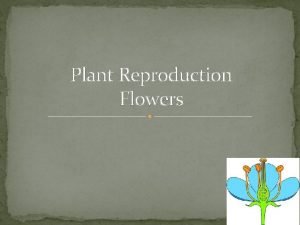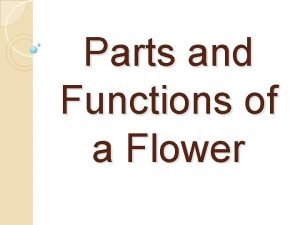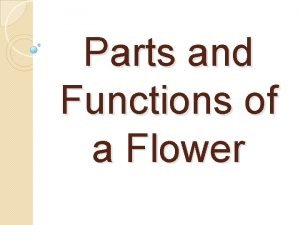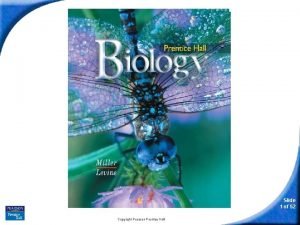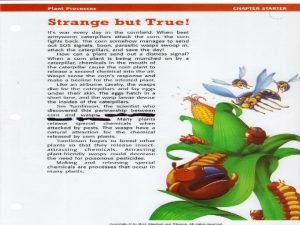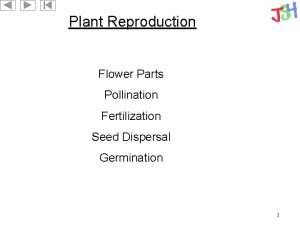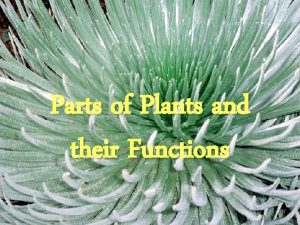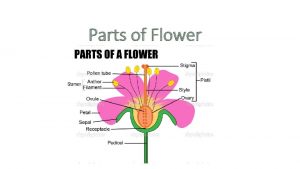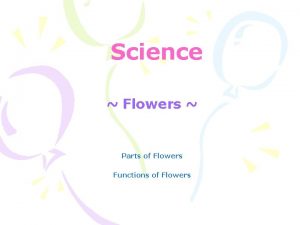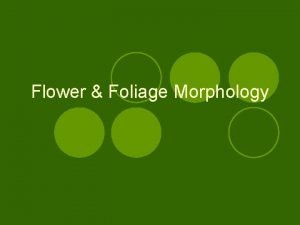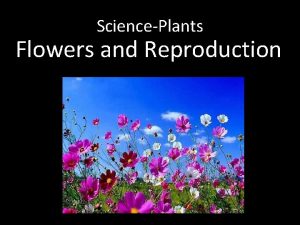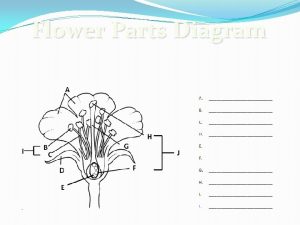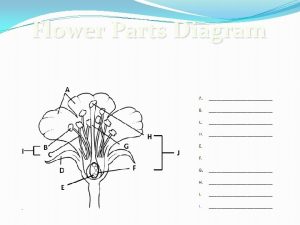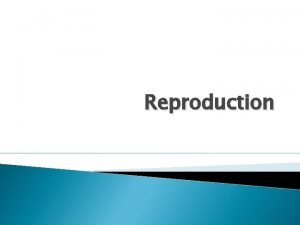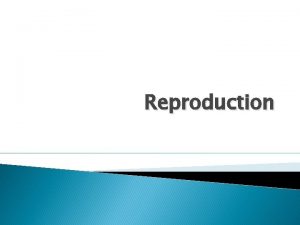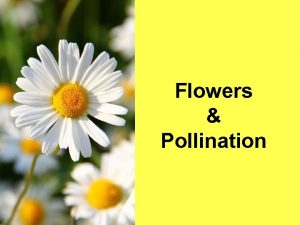Plant Reproduction Flowers Functions of Flower Parts 1












- Slides: 12

Plant Reproduction Flowers

Functions of Flower Parts 1 Petal- Ovary- Petals are used to attract insects into the flower, they may have guidelines on them and be scented. This protects the ovule and once fertilization has taken place it will become the fruit. Stigma- Ovule- Is covered in a sticky substance that the pollen grains will adhere to. The Ovule is like the egg in animals and once fertilization has taken place will become the seed. Style- Receptacle- The style raises the stigma away from the Ovary to decrease the likelihood of pollen contamination. It varies in length. This is the flower's attachment to the stalk and in some cases becomes part of the fruit after fertilization e. g. strawberry.

Functions of Flower Parts 2 Flower stalk- Filament- Gives support to the flower and elevates the flower for the insects. This is the stalk of the Anther. Nectary. This is where a sugary solution called nectar is held to attract insects. Sepals protect the flower whilst the flower is developing from a bud. Anther. The Anthers contain pollen sacs. The sacs release pollen on to the outside of the anthers that brush against insects on entering the flowers. Once the pollen is deposited on the insect. it is transferred to the stigma of another flower. The ovule is then able to be fertilized.


2 Types of flowers: Perfect vs. Imperfect Perfect �a flower that has either all male parts or all female parts �EX: cucumbers, pumpkin, and melons both male and female parts in the same flower �EX: roses, lilies, and dandelions

Pollination �Anther splits open when the pollen are mature �Pollen is carried to the stigma by wind, water, or animals. THIS is pollination �Plant reproduction is most successful when pollination rates are high Pollination is part of �Sexual reproduction, which results in greater genetic diversity (good for the species survival)

Pollination Vectors Wind Pollination: Dull, scentless flowers with reduced petals Bees/Butterfly Pollination: Bright color, nectaries, scent. They sip nectar, get pollen on coats, transfer pollen from flower to flower Bird Pollination: Nectaries, bright colors, tube-like flowers Moth Pollination: White petals, open at night Fly Pollination: Rank odor, flesh colored petals

Fertilization �Pollen is carried to the stigma in pollination �A pollen grain grows a tube down the style to the ovary �Two sperm travel down the tube �In a process called double fertilization, one of the sperm fertilizes the egg and the other unites with the central cell, forming an endosperm (which becomes food storage tissue) �IS THE UNITING OF THE SPERM AND EGG NUCLEI, CREATING A ZYGOTE.

Fruits and Seeds �Following fertilization, the ovary develops into a fruit with seeds inside, while the rest of the flower dies �Fruits help protect the seeds until they mature and help scatter seeds into new habitats -Fruits are the part of the plant that contains seeds: cucumbers, maple “helicopters”, green peppers, squash are all fruits.

�One or two cotyledons forms, which form leaves that will be used by the germinating seedling. �Food is derived from the endosperm �Thus, the seed is an undeveloped plant embryo with stored food and protective coats

Germination �At maturity, seed coat dries and hardens, enabling it to survive harsh conditions �Once conditions are favorable, seed germinates (develops into an embryo) and grows into a new plant.

 External parts of plants and their functions
External parts of plants and their functions Asexual reproduction cell division
Asexual reproduction cell division Sexual reproduction and asexual reproduction
Sexual reproduction and asexual reproduction Sexual vs asexual reproduction venn diagram
Sexual vs asexual reproduction venn diagram Part of the flower that contains pollen
Part of the flower that contains pollen Flower part functions
Flower part functions Flower parts and functions
Flower parts and functions Section 24-1 reproduction with cones and flowers
Section 24-1 reproduction with cones and flowers Gcf of 14 and 42
Gcf of 14 and 42 Function of flower
Function of flower Pistil
Pistil Function of leaves in plants
Function of leaves in plants Function of vacuole in plant cell
Function of vacuole in plant cell




